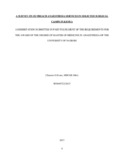| dc.contributor.author | Charana, Evans O | |
| dc.date.accessioned | 2017-12-13T06:35:21Z | |
| dc.date.available | 2017-12-13T06:35:21Z | |
| dc.date.issued | 2017 | |
| dc.identifier.uri | http://hdl.handle.net/11295/101810 | |
| dc.description.abstract | Background: Broadly defined, medical camps are stationary or mobile short term medical interventions for target communities, generally lasting from a day to a week. Surgical outreach aims to improve access to surgical services to patients who face financial or geographic barriers to surgical care and seeks to attend to as many patients as possible within a limited period.
One way to improve access to surgical services in sub-Saharan Africa would be to promote the provision of essential services and safe anaesthesia at the District Hospitals.
Providing anaesthesia care in remote locations may be challenging, as changed and variable environments pose unique problems.
Various studies have documented a slightly greater risk of unanticipated hospital admission and intraoperative event following ambulatory surgery.
Adequate monitoring in low resource settings has shown to reduce the rate of surgical complications, dropped infection complication and nearly halved the number of hypoxic episodes.
Objectives: The study aims to evaluate anesthetic practice in outreach anaesthesia in selected surgical camps in Kenya.
Methodology: The study was an observational Cross sectional survey study. The study was conducted in Surgical Medical camps in Kenya between July and December 2016. These included surgical camps conducted by Operation Ear Drop, Help a Child Face Tomorrow, Ophthalmology Camps, VVF and Surgical Society of Kenya. Two stage sampling was utilized to recruit participants in the study. A survey tool was used for data collection concerning the patients and the facility where the camp was held.
Results: A total of five selected surgical camps were surveyed which included 363 patients. The challenges faced in outreach anaesthesia ranged from anaesthesia drug supplies to inadequate monitoring equipment. Most of the patients attended to were ASA 1 and II. Airway complication were the common complication experienced in surgical camps. Most of the surgeries were carried out under regional anaesthesia
Conclusion: The challenges faced in outreach anaesthesia range from anaesthesia drug supplies to inadequate monitoring.
Recommendation: Efforts should be made to improve access to essential anesthetic drugs, invest in monitoring equipment in all operating rooms and train more anaesthesia providers to provide safe anaesthesia. | en_US |
| dc.language.iso | en | en_US |
| dc.publisher | University of Nairobi | en_US |
| dc.rights | Attribution-NonCommercial-NoDerivs 3.0 United States | * |
| dc.rights.uri | http://creativecommons.org/licenses/by-nc-nd/3.0/us/ | * |
| dc.subject | Survey on Outreach Anaesthesia | en_US |
| dc.title | A Survey on Outreach Anaesthesia Services in Selected Surgical Camps in Kenya | en_US |
| dc.type | Thesis | en_US |
| dc.description.department | a
Department of Psychiatry, University of Nairobi, ; bDepartment of Mental Health, School of Medicine,
Moi University, Eldoret, Kenya | |



